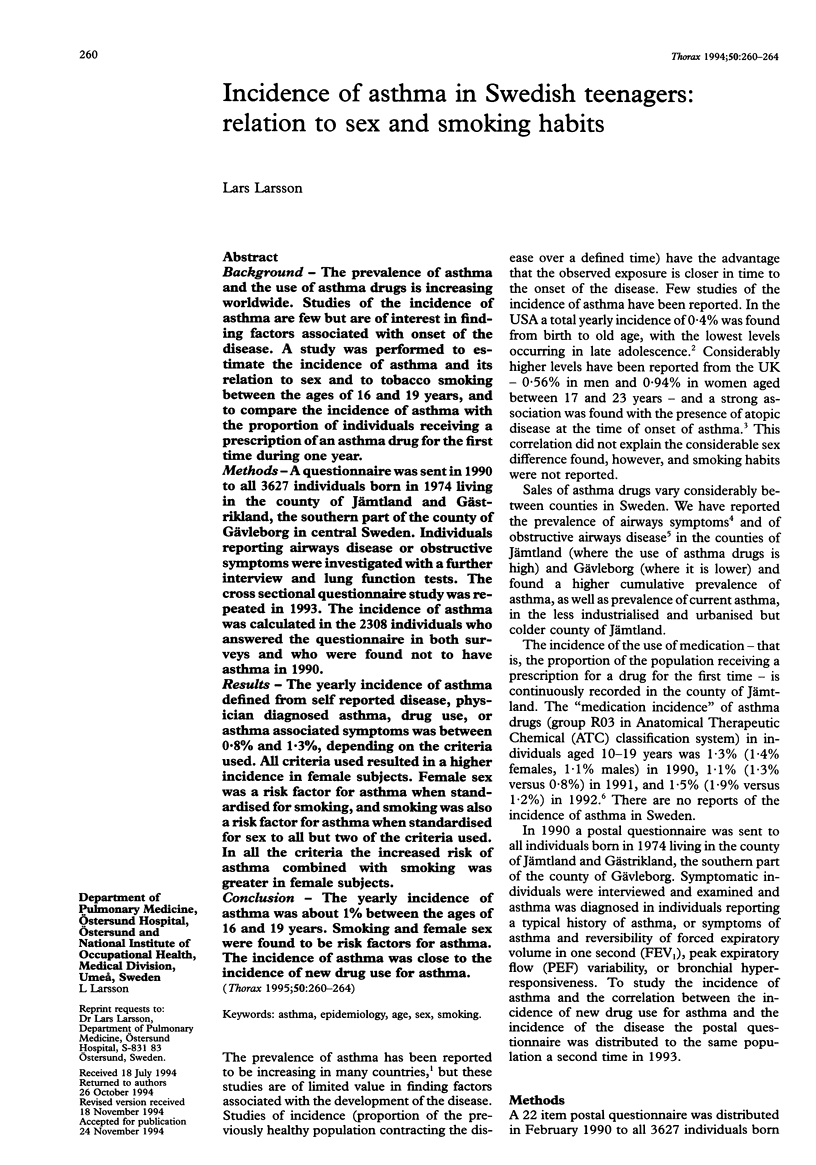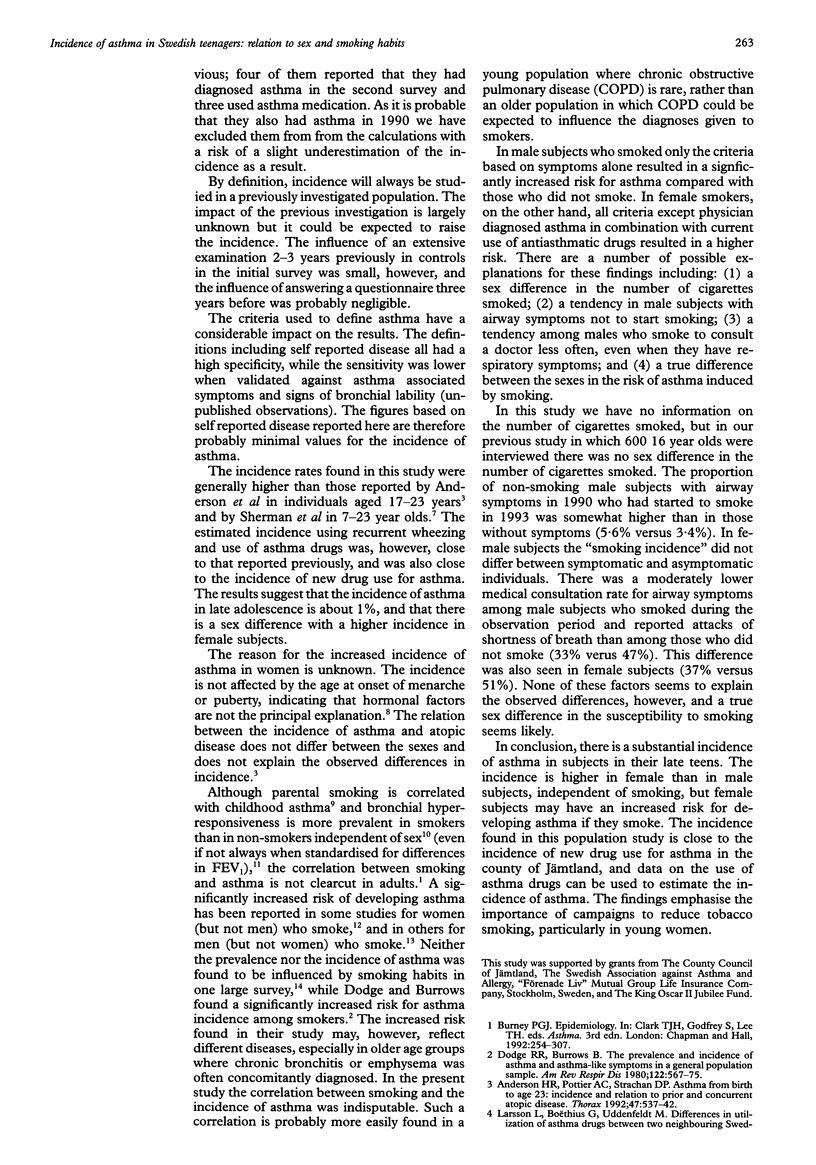Abstract
BACKGROUND--The prevalence of asthma and the use of asthma drugs is increasing worldwide. Studies of the incidence of asthma are few but are of interest in finding factors associated with onset of the disease. A study was performed to estimate the incidence of asthma and its relation to sex and to tobacco smoking between the ages of 16 and 19 years, and to compare the incidence of asthma with the proportion of individuals receiving a prescription of an asthma drug for the first time during one year. METHODS--A questionnaire was sent in 1990 to all 3627 individuals born in 1974 living in the county of Jämtland and Gästrikland, the southern part of the county of Gävleborg in central Sweden. Individuals reporting airways disease or obstructive symptoms were investigated with a further interview and lung function tests. The cross sectional questionnaire study was repeated in 1993. The incidence of asthma was calculated in the 2308 individuals who answered the questionnaire in both surveys and who were found not to have asthma in 1990. RESULTS--The yearly incidence of asthma defined from self reported disease, physician diagnosed asthma, drug use, or asthma associated symptoms was between 0.8% and 1.3%, depending on the criteria used. All criteria used resulted in a higher incidence in female subjects. Female sex was a risk factor for asthma when standardised for smoking, and smoking was also a risk factor for asthma when standardised for sex to all but two of the criteria used. In all the criteria the increased risk of asthma combined with smoking was greater in female subjects. CONCLUSION--The yearly incidence of asthma was about 1% between the ages of 16 and 19 years. Smoking and female sex were found to be risk factors for asthma. The incidence of asthma was close to the incidence of new drug use for asthma.
Full text
PDF




Selected References
These references are in PubMed. This may not be the complete list of references from this article.
- Anderson H. R., Bland J. M., Patel S., Peckham C. The natural history of asthma in childhood. J Epidemiol Community Health. 1986 Jun;40(2):121–129. doi: 10.1136/jech.40.2.121. [DOI] [PMC free article] [PubMed] [Google Scholar]
- Anderson H. R., Pottier A. C., Strachan D. P. Asthma from birth to age 23: incidence and relation to prior and concurrent atopic disease. Thorax. 1992 Jul;47(7):537–542. doi: 10.1136/thx.47.7.537. [DOI] [PMC free article] [PubMed] [Google Scholar]
- Dodge R. R., Burrows B. The prevalence and incidence of asthma and asthma-like symptoms in a general population sample. Am Rev Respir Dis. 1980 Oct;122(4):567–575. doi: 10.1164/arrd.1980.122.4.567. [DOI] [PubMed] [Google Scholar]
- Kiviloog J., Irnell L., Eklund G. The prevalence of bronchial asthma and chronic bronchitis in smokers and non-smokers in a representative local Swedish population. Scand J Respir Dis. 1974;55(5):262–276. [PubMed] [Google Scholar]
- Larsson L., Boëthius G., Uddenfeldt M. Differences in utilisation of asthma drugs between two neighbouring Swedish provinces: relation to prevalence of obstructive airway disease. Thorax. 1994 Jan;49(1):41–49. doi: 10.1136/thx.49.1.41. [DOI] [PMC free article] [PubMed] [Google Scholar]
- Larsson L., Boëthius G., Uddenfeldt M. Differences in utilization of asthma drugs between two neighbouring Swedish provinces: relation to symptom reporting. Eur Respir J. 1993 Feb;6(2):198–203. [PubMed] [Google Scholar]
- McWhorter W. P., Polis M. A., Kaslow R. A. Occurrence, predictors, and consequences of adult asthma in NHANESI and follow-up survey. Am Rev Respir Dis. 1989 Mar;139(3):721–724. doi: 10.1164/ajrccm/139.3.721. [DOI] [PubMed] [Google Scholar]
- Rijcken B., Schouten J. P., Mensinga T. T., Weiss S. T., De Vries K., Van der Lende R. Factors associated with bronchial responsiveness to histamine in a population sample of adults. Am Rev Respir Dis. 1993 Jun;147(6 Pt 1):1447–1453. doi: 10.1164/ajrccm/147.6_Pt_1.1447. [DOI] [PubMed] [Google Scholar]
- Sherman C. B., Tosteson T. D., Tager I. B., Speizer F. E., Weiss S. T. Early childhood predictors of asthma. Am J Epidemiol. 1990 Jul;132(1):83–95. doi: 10.1093/oxfordjournals.aje.a115646. [DOI] [PubMed] [Google Scholar]
- Vesterinen E., Kaprio J., Koskenvuo M. Prospective study of asthma in relation to smoking habits among 14,729 adults. Thorax. 1988 Jul;43(7):534–539. doi: 10.1136/thx.43.7.534. [DOI] [PMC free article] [PubMed] [Google Scholar]
- Weitzman M., Gortmaker S., Walker D. K., Sobol A. Maternal smoking and childhood asthma. Pediatrics. 1990 Apr;85(4):505–511. [PubMed] [Google Scholar]
- Woolcock A. J., Peat J. K., Salome C. M., Yan K., Anderson S. D., Schoeffel R. E., McCowage G., Killalea T. Prevalence of bronchial hyperresponsiveness and asthma in a rural adult population. Thorax. 1987 May;42(5):361–368. doi: 10.1136/thx.42.5.361. [DOI] [PMC free article] [PubMed] [Google Scholar]


